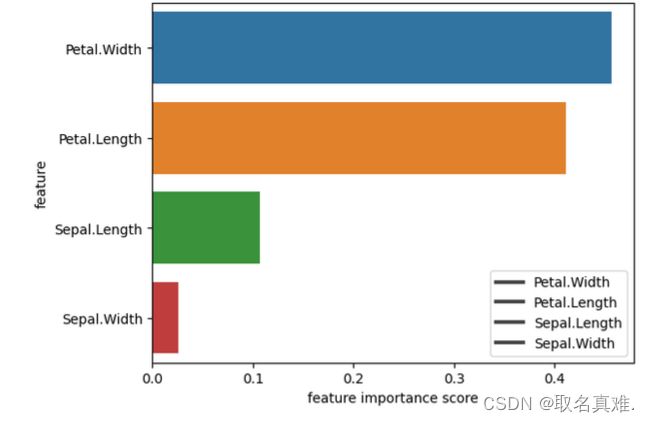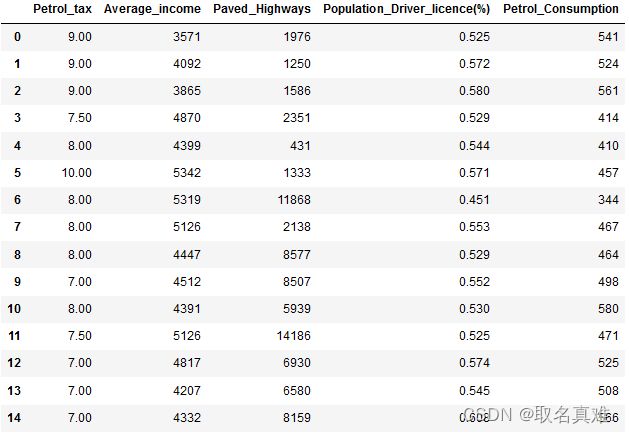随机森林,Random Forests Classifiers/Regressor
目录
介绍:
一、 Random Forests Classifiers(离散型)
1.1 数据处理
1.2建模
1.3特征值权值分析
1.4 特征值的缩减
二、Random Forests Regressor(连续型)
2.1数据处理
2.2建模
2.3调参
介绍:
随机森林(Random Forests)是一种集成学习算法,它由多个决策树组成。它在每个决策树的训练过程中引入了随机性,以提高模型的泛化能力和鲁棒性。
随机森林的训练过程如下:
- 从训练集中随机选取一部分样本,构建一个决策树。这种随机选取样本的过程叫做自助采样(bootstrap sampling)。
- 对于每个决策树的每个节点,从所有特征中随机选取一部分特征,根据这些特征来选择最优的分割点。
- 重复以上两个步骤,构建多个决策树。
- 预测时,将待预测样本输入到每个决策树中,得到多个预测结果。最终,根据这些预测结果进行投票或平均,确定最终的预测结果。
随机森林在许多方面都表现出良好的性能。它可以用于分类问题和回归问题,并且对于处理高维数据和大型数据集也非常有效。此外,随机森林能够处理缺失数据和不平衡数据,并能够评估特征的重要性。
总的来说,随机森林是一种强大的机器学习算法,它通过组合多个决策树的预测结果来提高模型的性能和鲁棒性。它在实际应用中广泛使用,并且具有很好的可解释性和通用性。
一、 Random Forests Classifiers(离散型)
1.1 数据处理
import numpy as np
import pandas as pd
import matplotlib.pyplot as plt
import seaborn as sns
%matplotlib inline
data=pd.read_csv('iris.csv')#离散型
X=data.iloc[:,1:5]
'''结果:
Sepal.Length Sepal.Width Petal.Length Petal.Width
0 5.1 3.5 1.4 0.2
1 4.9 3.0 1.4 0.2
2 4.7 3.2 1.3 0.2
3 4.6 3.1 1.5 0.2
4 5.0 3.6 1.4 0.2
... ... ... ... ...
145 6.7 3.0 5.2 2.3
146 6.3 2.5 5.0 1.9
147 6.5 3.0 5.2 2.0
148 6.2 3.4 5.4 2.3
149 5.9 3.0 5.1 1.8
150 rows × 4 columns
'''
y=data.iloc[:,-1:]
'''结果:
Species
0 setosa
1 setosa
2 setosa
3 setosa
4 setosa
... ...
145 virginica
146 virginica
147 virginica
148 virginica
149 virginica
150 rows × 1 columns
'''1.2建模
from sklearn.model_selection import train_test_split#将数据分成测试和训练集
X_train,X_test,y_train,y_test=train_test_split(X,y,test_size=0.3,random_state=0)#测试集占百分之三十,random_state=0随机抽取数据集里的成为测试集
from sklearn.ensemble import RandomForestClassifier#import random forest model
clf=RandomForestClassifier(n_estimators=100)#赋类,100棵树,后面可以调参
clf.fit(X_train,y_train)#训练集喂给这个模型
y_pred=clf.predict(X_test)#预测值
y_pred#预测值
'''结果:
array(['virginica', 'versicolor', 'setosa', 'virginica', 'setosa',
'virginica', 'setosa', 'versicolor', 'versicolor', 'versicolor',
'virginica', 'versicolor', 'versicolor', 'versicolor',
'versicolor', 'setosa', 'versicolor', 'versicolor', 'setosa',
'setosa', 'virginica', 'versicolor', 'setosa', 'setosa',
'virginica', 'setosa', 'setosa', 'versicolor', 'versicolor',
'setosa', 'virginica', 'versicolor', 'setosa', 'virginica',
'virginica', 'versicolor', 'setosa', 'virginica', 'versicolor',
'versicolor', 'virginica', 'setosa', 'virginica', 'setosa',
'setosa'], dtype=object)
'''
from sklearn import metrics
metrics.accuracy_score(y_test,y_pred)#模型的值,y_test,y_pred对比
#结果:0.97777777777777771.3特征值权值分析
#特征变量的权值分析
feature_list=list(X.columns)
feature_imp=pd.Series(clf.feature_importances_,index=feature_list).sort_values(ascending=False)
feature_imp#特征值的权重
'''结果:
Petal.Width 0.456188
Petal.Length 0.411471
Sepal.Length 0.106732
Sepal.Width 0.025609
dtype: float64
'''
feature_imp.index
#结果:Index(['Petal.Width', 'Petal.Length', 'Sepal.Length', 'Sepal.Width'], dtype='object')sns.barplot(x=feature_imp,y=feature_imp.index)
plt.xlabel('feature importance score')
plt.ylabel('feature')
plt.legend(feature_imp.index)
plt.show()1.4 特征值的缩减
#特征变量的缩减,对于成百上千特征变量的大数据非常有意义
X=data.iloc[:,1:-2]
'''结果:
Sepal.Length Sepal.Width Petal.Length
0 5.1 3.5 1.4
1 4.9 3.0 1.4
2 4.7 3.2 1.3
3 4.6 3.1 1.5
4 5.0 3.6 1.4
... ... ... ...
145 6.7 3.0 5.2
146 6.3 2.5 5.0
147 6.5 3.0 5.2
148 6.2 3.4 5.4
149 5.9 3.0 5.1
150 rows × 3 columns
'''
X_train,X_test,y_train,y_test=train_test_split(X,y,test_size=0.3,random_state=0)#测试集占百分之三十,random_state=0随机抽取数据集里的成为测试集
clf=RandomForestClassifier(n_estimators=100)#赋类,100棵树,后面可以调参
clf.fit(X_train,y_train)#训练集喂给这个模型
y_pred=clf.predict(X_test)#预测值
metrics.accuracy_score(y_test,y_pred)#模型的值,y_test,y_pred对比
#结果:0.9333333333333333二、Random Forests Regressor(连续型)
2.1数据处理
dataset = pd.read_csv('petrol_consumption.csv')
dataset#汽油税,收入,高速费,人口密度,汽油消耗
dataset.info()
'''结果:
RangeIndex: 48 entries, 0 to 47
Data columns (total 5 columns):
# Column Non-Null Count Dtype
--- ------ -------------- -----
0 Petrol_tax 48 non-null float64
1 Average_income 48 non-null int64
2 Paved_Highways 48 non-null int64
3 Population_Driver_licence(%) 48 non-null float64
4 Petrol_Consumption 48 non-null int64
dtypes: float64(2), int64(3)
memory usage: 2.0 KB
'''
X = dataset.iloc[:,0:4]
y=dataset.iloc[:,4] #数据差异非常大,需要引入数据标准化
from sklearn.preprocessing import StandardScaler
sc = StandardScaler()
X_train = sc.fit_transform(X_train)
X_test=sc.transform(X_test)
X_train
'''结果:
array([[-0.60684249, -0.13370363, -0.39371558, 0.71661097],
[-0.60684249, 0.73650306, 0.12337074, 2.41961586],
[-0.60684249, -0.08812138, 1.37233744, 0.09273789],
[ 0.33674156, -0.35747107, 0.14030588, -0.29507511],
[ 1.28032561, 1.11152071, -0.85491594, -1.1718697 ],
[-0.60684249, -0.3201765 , 0.85525111, -0.14332219],
[-0.60684249, -1.45973288, -0.42137631, -0.29507511],
[-0.60684249, 0.48165682, 0.66501302, 1.39106835],
[-0.60684249, -0.12541595, -0.52016464, 0.37938228],
[ 0.33674156, 0.17915639, 0.87472653, -0.86836388],
[-0.60684249, -0.31810458, 0.31106856, -0.59858093],
[ 1.28032561, -1.32505804, -0.20658227, -0.61544236],
[ 2.22390966, 2.03352542, -1.16990957, -0.16018363],
[-0.60684249, -1.3312738 , -0.21250957, -0.6828881 ],
[-1.00314779, -1.15723246, 0.66501302, 0.81777958],
[-0.60684249, -0.05911449, 0.75674504, 0.46368945],
[ 0.80853358, -1.50324322, -0.62205774, 1.39106835],
[ 1.28032561, -0.55637546, -1.19333652, -0.14332219],
[-0.60684249, 0.94576705, 0.40985689, -0.10959932],
[-0.60684249, -1.27533194, -0.80919106, -1.22245401],
[ 0.80853358, 0.44229032, -0.80693304, -0.49741232],
[ 0.33674156, 1.98587124, 1.80361904, -2.18355578],
[ 1.28032561, -0.21243662, -0.22351741, -1.0707011 ],
[-2.49401059, -0.65375573, 3.4728595 , -0.2444908 ],
[ 0.33674156, 1.28970589, -1.37623605, 0.36252084],
[ 0.80853358, -0.0404672 , 0.15018472, 1.62712844],
[-0.60684249, 0.31383124, 0.85496886, -0.48055089],
[-0.60684249, -0.03217952, -0.4439565 , 1.54282127],
[ 1.28032561, 0.23924209, -0.43351316, -0.16018363],
[-0.13505047, 1.05557885, -0.88257667, -0.86836388],
[ 1.28032561, -1.63584614, -0.9884213 , -0.93580962],
[-1.55042654, 1.77039149, -0.89640703, 1.54282127]])
'''2.2建模
from sklearn.ensemble import RandomForestRegressor
regressor = RandomForestRegressor(n_estimators=100,random_state=0)
regressor.fit(X_train,y_train)
y_pred = regressor.predict(X_test)
#结果:array([586.98, 489.34, 626.27, 658.65, 631.72, 614.6 , 612.19, 579.32,
# 465.44, 512.32, 438.32, 657.18, 624.52, 598.46, 534.4 , 555.78])
from sklearn import metrics
print('Mean Absolute Error',metrics.mean_absolute_error(y_test,y_pred))
print('Mean Squared Error',metrics.mean_squared_error(y_test,y_pred))
print('root mean squared error',np.sqrt(metrics.mean_squared_error(y_test,y_pred)))
'''结果:
Mean Absolute Error 50.18562499999999
Mean Squared Error 3964.588093749999
root mean squared error 62.964975134990716
'''2.3调参
rmse=nestimators=[]#调参
for n in [20,30,50,80,100,200,300,400,500,600,700,800]:
regressor = RandomForestRegressor(n_estimators=n,random_state=0)
regressor.fit(X_train,y_train)
y_pred = regressor.predict(X_test)
print('-------------------')
print('n_estimators={}',format(n))
print('Mean Absolute Error',metrics.mean_absolute_error(y_test,y_pred))
print('Mean Squared Error',metrics.mean_squared_error(y_test,y_pred))
print('Root mean squared error',np.sqrt(metrics.mean_squared_error(y_test,y_pred)))
rmse=np.append(rmse,np.sqrt(metrics.mean_squared_error(y_test,y_pred)))
nestimators=np.append(nestimators,n)
'''结果:
-------------------
n_estimators={} 20
Mean Absolute Error 56.128125000000004
Mean Squared Error 4606.41578125
Root mean squared error 67.87058111766835
-------------------
n_estimators={} 30
Mean Absolute Error 49.94375000000001
Mean Squared Error 3922.442708333335
Root mean squared error 62.62940769585271
-------------------
n_estimators={} 50
Mean Absolute Error 49.158750000000005
Mean Squared Error 3868.3672749999996
Root mean squared error 62.19619984372035
-------------------
n_estimators={} 80
Mean Absolute Error 50.70390625
Mean Squared Error 4013.614755859375
Root mean squared error 63.35309586641662
-------------------
n_estimators={} 100
Mean Absolute Error 50.18562499999999
Mean Squared Error 3964.588093749999
Root mean squared error 62.964975134990716
-------------------
n_estimators={} 200
Mean Absolute Error 48.34375
Mean Squared Error 3622.057096875
Root mean squared error 60.18352845152069
-------------------
n_estimators={} 300
Mean Absolute Error 49.467708333333334
Mean Squared Error 3789.9574437499987
Root mean squared error 61.5626302536693
-------------------
n_estimators={} 400
Mean Absolute Error 48.489999999999995
Mean Squared Error 3636.7144398437504
Root mean squared error 60.30517755420135
-------------------
n_estimators={} 500
Mean Absolute Error 48.917499999999976
Mean Squared Error 3726.081923499998
Root mean squared error 61.041640897833
-------------------
n_estimators={} 600
Mean Absolute Error 48.97749999999999
Mean Squared Error 3719.864061805555
Root mean squared error 60.990688320476885
-------------------
n_estimators={} 700
Mean Absolute Error 48.50473214285714
Mean Squared Error 3633.144154209183
Root mean squared error 60.275568468569276
-------------------
n_estimators={} 800
Mean Absolute Error 48.12984374999999
Mean Squared Error 3560.1158533203115
Root mean squared error 59.66670640583668
'''rmse
'''结果:
array([67.87058112, 62.6294077 , 62.19619984, 63.35309587, 62.96497513,
60.18352845, 61.56263025, 60.30517755, 61.0416409 , 60.99068832,
60.27556847, 59.66670641])
'''
sns.set_style('whitegrid')
plt.plot(nestimators,rmse,'bo',linestyle='dashed',linewidth=1,markersize=10)#前面x,后面y
plt.xlabel('feature importance score')
plt.ylabel('features')
plt.title("viualizing importeant features")
plt.show()

